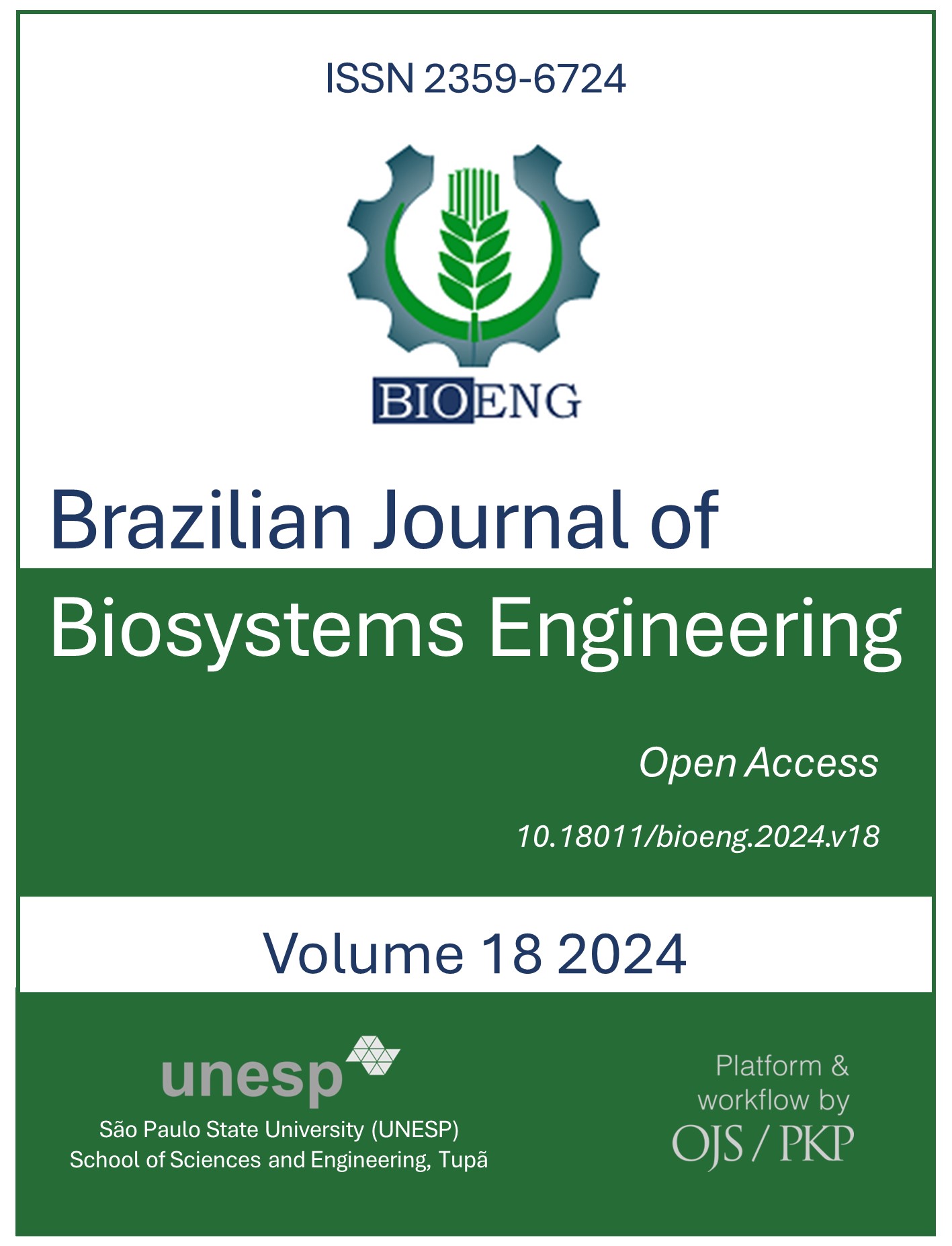Influence of good practices training and milking systems on standard plate count of dairy properties in a municipality in the interior of São Paulo state
DOI:
https://doi.org/10.18011/bioeng.2024.v18.1245Keywords:
Family farming, Food microbiology, Good manufaturing practices, Milk quality, Rural extensionAbstract
Milk is a product of great economic, social, and nutritional importance for the Brazilian population. However, the lack of proper hygiene and sanitization during the milking process, whether manual or mechanical, the equipment used in the process, and the storage of milk, coupled with a lack of access to knowledge on good sanitary practices, represents a significant risk to the quality and quantity of milk produced and marketed. Thus, this study aimed to verify the influence of good practices training in milking and the type of milking (manual or mechanical) on the standard plate count (SPC) concentration in milk from small-scale dairy farms in Bastos-SP, Brazil. Three sample collections were carried out: one before and two after a good sanitary practice training in the milking process to assess its impact on the microbiological quality of production from 14 dairy farms. An exploratory and statistical analysis of the milk results was conducted. Values exceeding the national legislation’s accepted limits for SPC were found, and no significant difference was observed between the pre- and post-training collections or between the types of milking. The study demonstrated that the intervention methodology could influence producer behavior, considering that the single intervention used was group training, which did not effectively result in the implementation and maintenance of good sanitary practices in the milking process.
Downloads
References
Ayer, J.E., Olivetti, D., Mincato, R. L. & Silva, M. L. (2015). Erosão hídrica Ahmad, S., Kumar,D., Sharma, S., Ghaji, M. T. (2020). Adoption of clean milk production practices by dairy farm workers: A systemic review study. International Journal of Nursing Care, 8(2), 41-45. https://medicopublication.com/index.php/ijonc/article/view/11283/10437
Ahmed, Z. A., Kasim, M. H., Tegegne, B., Salah, H. M. (2022). Assessment of hygiene practices and bacteriological quality of raw cow milk of selected dairy farm in Dessie, Ethiopia. American Journal of Aquaculture and Animal Science, 1(1), 27-37. https://doi.org/10.54536/ajaas.v1i1.1071. DOI: https://doi.org/10.54536/ajaas.v1i1.1071
Amancio, O. M. S. et al. A importância do consumo de leite no atual cenário nutricional brasileiro. São Paulo, SP: Sban, v. 28, p. 28, 2015. Disponível em: http://sban.cloudpainel.com.br/source/SBAN_Importancia-do-consumo-de-leite.pdf
Beloti, V., Dias, J. A., Oliveira, A. M. (2020). Ordenha e boas práticas de produção. Embrapa. Brasília, DF: Embrapa. https://ainfo.cnptia.embrapa.br/digital/bitstream/item/217359/1/cpafro-18460.pdf?locale=es
BRASIL. (2003). Ministério da Agricultura, Pecuária e Abastecimento (MAPA). Instrução normativa no 62, de 26 de agosto de 2003. Oficializar os Métodos Analíticos Oficiais para Análises Microbiológicas para Controle de Produtos de Origem Animal e Água. Diário Oficial da União, Brasília, DF, 18 set 2003, p.14, Seção 1.
FAO; IFAD; UNICEF; WFP; WHO. (2022). The State of Food Security and Nutrition in the World 2022: Repurposing food and agricultural policies to make healthy diets more affordable. FAO. https://doi.org/10.4060/cc0639en DOI: https://doi.org/10.4060/cc0639en
Franco, B. D. G. M., Landgraf, M. (2008). Microbiologia dos Alimentos. Editora Atheneu 1ºed, 192p.
Kusumah, N. A. F., Widjiati, W., Puspitasari, Y., Tyasningsih, W., Wardhana, D. K., Permatasari, D. A., Luqman, E. M. (2023) Comparison of total number of bacteria in raw milk Friesian Holstein cow based on milking techniques using Total Plate Count (TPC) Test. International Journal of Scientific Advances, 4(1), 1-7. https://doi.org/10.51542/ijscia.v4i1.9 DOI: https://doi.org/10.51542/ijscia.v4i1.9
Maia, A. G. (2002). Valuation of environmental resources. 183f. Tesis (Master) - UNICAMP, Campinas.
MAPA. Ministério da Agricultura, Pecuária e Abastecimento. Instrução Normativa N° 76, de 26 de Novembro de 2018. Brasília: Mapa, 2018 a.
MAPA. Ministério da Agricultura, Pecuária e Abastecimento. Instrução Normativa N° 77, de 26 de Novembro de 2018. Brasília: Mapa, 2018 b.
Moya, S., Tirado, F., Espluga, J., Ciaravino, G., Armengol, R., Diéguez, J., Yus, E., Benvides, B., Casal, J., Allepuz, A. (2019). Dairy farmers’ decision-making to implement biosecurity measures: A study of psychosocial factors. Transboundary and Emerging Diseases, 66(5), 2290-2301. https://onlinelibrary.wiley.com/doi/10.1111/tbed.13387
Nyokabi, S., Luning, P. A., Boer, I. J. M. de, Korir, L., Muuda, E., Bebe, B. O., Lindahl, J., Bett, B., Oosting, S. J. (2021). Milk quality and hygiene: Knowledge, attitudes and practices of smallholder dairy farmers in central Kenya. Food Control, 130:108303. https://doi.org/10.1016/j.foodcont.2021.108303 DOI: https://doi.org/10.1016/j.foodcont.2021.108303
ONU. Organização das Nações Unidas. (2015) Os Objetivos de Desenvolvimento Sustentável. 2023. Disponível em: https://brasil.un.org/pt-br
Rosa, M. S., Costa, M. J. R. P., SANT´ANNA, A. C., MADUREIRA, A. P. (2014). Manual de Boas Práticas de Manejo-Ordenha. 2ªEd. Jaboticabal: Funep. https://livraria.funep.org.br/product/e-book-boas-praticas-de-manejo-ordenha/
Santos, I. G. M. A. (2023). Effects of Sanitary Practices on Milking Process on Microbiological Parameters of Bovine Milk in a municipality in the Alta Paulista Region. 97p. Master Thesis (Master in Agribusiness and Development) – São Paulo State University (UNESP), School of Sciences and Engineering. Tupã.
Zareie, R., Zamani, G. H., Karami, E. (2016). The effect of dairy farmers’ technical knowledge on milk bacterial count. Specialty Journal of Agricultural Sciences, 2(1), 69-74. https://sciarena.com/article/the-effect-of-dairy-farmers-technical-knowledge-on-milk-bacterial-count
Downloads
Published
How to Cite
Issue
Section
License
Copyright (c) 2024 Revista Brasileira de Engenharia de Biossistemas

This work is licensed under a Creative Commons Attribution 4.0 International License.
Authors who publish in this journal agree to the following terms:
a) Authors retain the copyright and grant the journal the right of first publication, with the work simultaneously licensed under the Creative Commons Attribution License that allows the sharing of the work with recognition of authorship and initial publication in this journal.
b) Authors are authorized to assume additional contracts separately, for non-exclusive distribution of the version of the work published in this journal (eg, publish in an institutional repository or as a book chapter), with recognition of authorship and initial publication in this journal.








